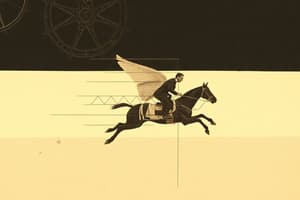Podcast
Questions and Answers
What does the variable 'v' represent in the equation of motion?
What does the variable 'v' represent in the equation of motion?
- Final velocity of the object (correct)
- Initial velocity of the object
- Time during which the acceleration occurs
- Acceleration of the object
What happens when acceleration 'a' is equal to zero in the equation of motion?
What happens when acceleration 'a' is equal to zero in the equation of motion?
- The object experiences negative acceleration
- The object stops moving
- The object speeds up immediately
- The object moves at constant velocity (correct)
How can you rearrange the equation v = u + at to find the time 't'?
How can you rearrange the equation v = u + at to find the time 't'?
- t = (v + u) / a
- t = (v - u) / a (correct)
- t = (a - u) / v
- t = (u - v) / a
In the context of linear motion, when acceleration 'a' is negative, what does it indicate?
In the context of linear motion, when acceleration 'a' is negative, what does it indicate?
When plotting a velocity-time graph, what does the slope represent?
When plotting a velocity-time graph, what does the slope represent?
Flashcards are hidden until you start studying
Study Notes
Equation of Motion: v = u + at
-
Definitions:
- v: Final velocity of the object (m/s)
- u: Initial velocity of the object (m/s)
- a: Acceleration (m/s²)
- t: Time (s) during which the acceleration occurs
-
Concepts:
- This equation describes the relationship between initial velocity, final velocity, acceleration, and time for an object moving in a straight line under uniform acceleration.
- It is applicable in linear motion scenarios where the acceleration is constant.
-
Key Points:
- If a = 0: The object moves at constant velocity, thus v = u.
- If a > 0: The object speeds up (positive acceleration).
- If a < 0: The object slows down (negative acceleration or deceleration).
-
Rearranging the Equation:
- To find acceleration: a = (v - u) / t
- To find time: t = (v - u) / a
- To find initial velocity: u = v - at
-
Applications:
- Used in solving problems related to freely falling objects, vehicles accelerating on a straight path, etc.
- Helps in predicting the motion of objects when the initial conditions are known.
-
Graphical Representation:
- A velocity-time graph can be plotted where:
- The slope represents acceleration (a).
- The area under the graph represents the distance traveled.
- A velocity-time graph can be plotted where:
-
Example Problem:
- If a car starts from rest (u = 0 m/s) and accelerates at 2 m/s² for 5 seconds, calculate final velocity (v).
- v = u + at = 0 + (2 * 5) = 10 m/s.
- If a car starts from rest (u = 0 m/s) and accelerates at 2 m/s² for 5 seconds, calculate final velocity (v).
-
Units:
- Ensure all quantities are in SI units for consistency (m/s for velocity, m/s² for acceleration, s for time).
Key Definitions
- v: Final velocity, measured in meters per second (m/s).
- u: Initial velocity, also measured in meters per second (m/s).
- a: Acceleration, measured in meters per second squared (m/s²).
- t: Time during which acceleration occurs, measured in seconds (s).
Fundamental Concepts
- The equation v = u + at expresses the relationship among initial velocity, final velocity, acceleration, and time for an object under uniform acceleration.
- Applicable to linear motion scenarios with constant acceleration.
Important Points
- When a = 0: The object maintains constant velocity, thus v = u.
- When a > 0: The object experiences positive acceleration, leading to an increase in speed.
- When a < 0: The object undergoes negative acceleration (deceleration), resulting in a decrease in speed.
Rearranging the Equation
- To determine acceleration: a = (v - u) / t
- To determine time: t = (v - u) / a
- To determine initial velocity: u = v - at
Practical Applications
- Useful in analyzing motion for freely falling objects, vehicles accelerating along a straight path, and similar scenarios.
- Provides a means to predict object motion based on known initial conditions.
Graphical Representation
- Velocity-time graphs illustrate motion characteristics:
- The slope of the graph indicates acceleration (a).
- The area beneath the graph represents the distance traveled by the object.
Example Problem
- A car starting from rest (u = 0 m/s) accelerates at 2 m/s² for 5 seconds.
- Calculate final velocity: v = u + at = 0 + (2 * 5) = 10 m/s.
Unit Consistency
- Ensure all quantities are expressed in SI units for accurate calculations:
- Velocity in m/s
- Acceleration in m/s²
- Time in seconds (s)
Studying That Suits You
Use AI to generate personalized quizzes and flashcards to suit your learning preferences.




